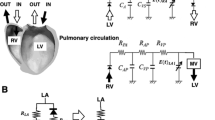Abstract
Purpose
Patient-specific biomechanical simulations of the behavior of soft tissue gain importance in current surgery assistance systems as they can provide surgeons with valuable ancillary information for diagnosis and therapy. In this work, we aim at supporting minimally invasive mitral valve reconstruction (MVR) surgery by providing scenario setups for FEM-based soft tissue simulations, which simulate the behavior of the patient-individual mitral valve subject to natural forces during the cardiac cycle after an MVR. However, due to the complexity of these simulations and of their underlying mathematical models, it is difficult for non-engineers to sufficiently understand and adequately interpret all relevant modeling and simulation aspects. In particular, it is challenging to set up such simulations in automated preprocessing workflows such that they are both patient-specific and still maximally comprehensive with respect to the model.
Methods
In this paper, we address this issue and present a fully automated chain of preprocessing operators for setting up comprehensive, patient-specific biomechanical models on the basis of patient-individual medical data. These models are suitable for FEM-based MVR surgery simulation. The preprocessing methods are integrated into the framework of the Medical Simulation Markup Language and allow for automated information processing in a data-driven pipeline.
Results
We constructed a workflow for holistic, patient-individual information preprocessing for MVR surgery simulations. In particular, we show how simulation preprocessing can be both fully automated and still patient-specific, when using a series of dedicated MVR data analytics operators. The outcome of our operator chain is visualized in order to help the surgeon understand the model setup.
Conclusion
With this work, we expect to improve the usability of simulation-based MVR surgery assistance, through allowing for fully automated, patient-specific simulation setups. Combined visualization of the biomechanical model setup and of the corresponding surgery simulation results fosters the understandability and transparency of our assistance environment.










Similar content being viewed by others
References
Carpentier A, Chauvaud S, Fabiani JN et al (1980) Reconstructive surgery of mitral valve incompetence: ten-year appraisal. J Thorac Cardiovasc Surg 79(3):338–348
Choi A, Rim Y, Mun JS, Kim H (2014) A novel finite element-based patient-specific mitral valve repair: virtual ring annuloplasty. Biomed Mater Eng 24(1):341–347
Engelhardt S, Lichtenberg N et al (2015) Towards automaticassessment of the mitral valve coaptation zone from 4D ultrasound. In: Proceedings of FIMH, Lecture notes in compute science, pp 137–145
Gonzalez TF (1985) Clustering to minimize the maximum intercluster distance. J Theor Comput Sci 38:293–306
Anzt H, Augustin W et al (2012) HiFlow3—a hardware-aware parallel finite element package. Tools High Perform Comput 2011:139–151
Jokinen J, Hippelainen MJ, Pitkaenen OA, Hartikainen JE (2007) Mitral valve replacement versus repair: Propensity-adjusted survival and quality-of-life analysis. Ann Thorac Surg 84(2):451–458
Maisano F, Skantharaja R, Denti P, Giacomini A, Alfieri O (2009) Mitral annuloplasty. Multimed Man Cardio-Thorac Surg 2009(0918):1–8. doi:10.1510/mmcts.2008.003640
Mansi T, Voigt I, Georgescu B et al (2012) An integrated framework for finite-element modeling of mitral valve biomechanics from medical images: application to MitralClip intervention planning. Med Image Anal 16(7):1330–1346
Norajitra T, Meinzer HP, Maier-Hein K (2015) 3D statistical shape models incorporating 3D random forest regression voting for robustCT liver segmentation. In: Proceedings of SPIE 9414 Medical Imaging, 9414-06
Pouch AM, Xu C et al (2012) Semi-automated mitral valve morphometry and computational stress analysis using 3D ultrasound. J Biomech 45(5):903–907
Schoch N, Engelhardt S, Zimmermann N et al (2015) Integration of a biomechanical simulation for mitral valve reconstruction into a knowledge-based surgery assistance system. In: Proceedings of SPIE 9415 Medical Imaging, 9415-02
Schoch N, Engelhardt S, Simone RD, Wolf I, Heuveline V (2015) High performance computing for cognition-guided cardiac surgery: soft tissue simulation for mitral valve reconstruction in knowledge-based surgery assistance. In: Proceedings of 6th HPSC (submitted)
Schoch N, Philipp P, Weller T et al (2016) Cognitive tools pipeline for assistance of mitral valve surgery. In: Proceedings of SPIE 9786 Medical Imaging, 9786-02
Suwelack S, Stoll M, Schalck S, Schoch N et al (2014) The medical simulation markup language—simplifying the biomechanical modeling workflow. J Stud Health Technol Inform 196:394–400
Votta E, Le TB, Stevanella M et al (2013) Toward patient-specific simulations of cardiac valves: state-of-the-art and future directions. J Biomech 46(2):217–228
Acknowledgments
This work was carried out with the support of the German Research Foundation (DFG) within the Projects I03, B01 and C02 of the Collaborative Research Center SFB/TRR 125 “Cognition-Guided Surgery.”
Author information
Authors and Affiliations
Corresponding author
Ethics declarations
Conflict of interest
The authors declare that they have no conflict of interest.
Ethical approval
All procedures performed in studies involving human participants were in accordance with the ethical standards of the institutional and/or national research committee and with the 1964 Helsinki Declaration, its later amendments or comparable ethical standards.
Informed consent
Informed consent was obtained from all individual participants included in the study.
Rights and permissions
About this article
Cite this article
Schoch, N., Kißler, F., Stoll, M. et al. Comprehensive patient-specific information preprocessing for cardiac surgery simulations. Int J CARS 11, 1051–1059 (2016). https://doi.org/10.1007/s11548-016-1397-0
Received:
Accepted:
Published:
Issue Date:
DOI: https://doi.org/10.1007/s11548-016-1397-0




